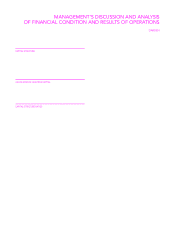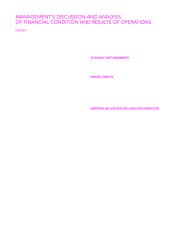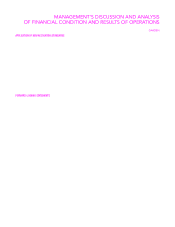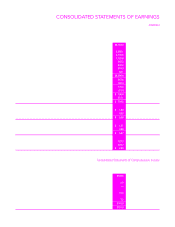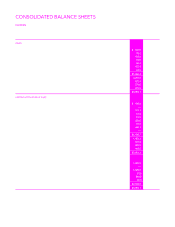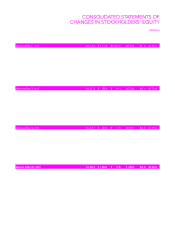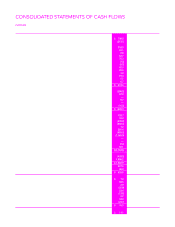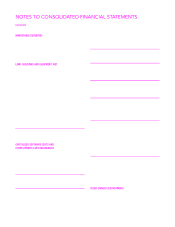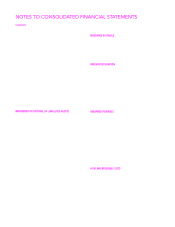Red Lobster 2015 Annual Report Download - page 35
Download and view the complete annual report
Please find page 35 of the 2015 Red Lobster annual report below. You can navigate through the pages in the report by either clicking on the pages listed below, or by using the keyword search tool below to find specific information within the annual report.
DARDEN RESTAURANTS, INC. | 2015 ANNUAL REPORT 31
NOTES TO CONSOLIDATED FINANCIAL STATEMENTS
DARDEN
NOTE 1
SUMMARY OF SIGNIFICANT ACCOUNTING POLICIES
OPERATIONS AND PRINCIPLES OF CONSOLIDATION
The accompanying consolidated financial statements include the operations
of Darden Restaurants, Inc. and its wholly owned subsidiaries (Darden, the
Company, we, us or our). We own and operate the Olive Garden®, LongHorn
Steakhouse®, The Capital Grille®, Yard House®, Bahama Breeze®, Seasons 52®,
and Eddie V’s Prime Seafood® and Wildfish Seafood Grille® (collectively,
“Eddie V’s”) restaurant brands located in the United States and Canada.
Through subsidiaries, we own and operate all of our restaurants in the United
States and Canada, except for three restaurants located in Central Florida
and three restaurants in California that we manage, but are jointly owned
with third parties, two franchised U.S. airport restaurants and eight franchised
restaurants in Puerto Rico. We also have area development and franchise
agreements with unaffiliated operators to develop and operate our brands
primarily in Asia, the Middle East and Latin America. Pursuant to these agree-
ments, as of May 31, 2015, 24 franchised restaurants were in operation in
the Middle East, Mexico, Brazil, Peru, El Salvador and Malaysia. All significant
inter-company balances and transactions have been eliminated in consolidation.
BASIS OF PRESENTATION
On May 15, 2014, we entered into an agreement to sell Red Lobster and
certain related assets and associated liabilities and closed the sale on July 28,
2014. During fiscal 2007 and 2008, we closed or sold all of our Smokey
Bones Barbeque & Grill (Smokey Bones) and Rocky River Grillhouse restaurants
and we closed nine Bahama Breeze restaurants. For fiscal 2015, 2014 and
2013 all gains and losses on disposition, impairment charges and disposal
costs, along with the sales, costs and expenses and income taxes attributable
to the discontinued locations, have been aggregated in a single caption entitled
“Earnings from discontinued operations, net of tax expense” in our consolidated
statements of earnings for all periods presented. See Note 2 – Dispositions
for additional information.
Unless otherwise noted, amounts and disclosures throughout these notes
to consolidated financial statements relate to our continuing operations.
FISCAL YEAR
We operate on a 52/53 week fiscal year, which ends on the last Sunday in May,
which for fiscal 2015 was May 31, 2015. Accordingly, fiscal 2015 consisted
of 53 weeks of operation. Fiscal 2014 and 2013, which ended May 25, 2014
and May 26, 2013, respectively, each consisted of 52 weeks of operation.
USE OF ESTIMATES
We prepare our consolidated financial statements in conformity with U.S.
generally accepted accounting principles. The preparation of these financial
statements requires us to make estimates and assumptions that affect the
reported amounts of assets and liabilities and disclosure of contingent
assets and liabilities at the date of the financial statements, and the reported
amounts of sales and expenses during the reporting period. Actual results
could differ from those estimates.
RECLASSIFICATIONS
We have reclassified certain amounts in prior-period financial statements to
conform to the current period’s presentation. Included among these, in our
consolidated statements of earnings, we revised the categories in our costs
and expenses as follows: marketing expenses and general and administrative
expenses, previously reported as components of selling, general and admin-
istrative expenses, are now reported as separate line items. Additionally, gains
and losses on disposals of assets, previously reported as a component of
selling, general and administrative expenses are now reported in impairments
and disposal of assets, net. On our consolidated balance sheets, we have
reclassified our obligations under capital leases, net of current installments
to be included in other liabilities. Additionally, in connection with the adoption
of Financial Accounting Standards Board (FASB) Accounting Standards
Update (ASU) 2015-03, Interest – Imputation of Interest (Subtopic 835-30),
Simplifying the Presentation of Debt Issuance Costs, we have reclassified
debt issuance costs associated with our long-term debt from other assets to
long-term debt, less current portion (see Note 9 – Debt).
CASH AND CASH EQUIVALENTS
Cash equivalents include highly liquid investments such as U.S. Treasury
bills, taxable municipal bonds and money market funds that have an original
maturity of three months or less. Amounts receivable from credit card
companies are also considered cash equivalents because they are both
short term and highly liquid in nature and are typically converted to cash
within three days of the sales transaction.
The components of cash and cash equivalents are as follows:
May 31, May 25,
(in millions)
2015 2014
Short-term investments $455.5 $ 0.5
Credit card receivables 77.8 92.0
Depository accounts 2.6 5.8
Total Cash and Cash Equivalents $535.9 $98.3
As of May 31, 2015, and May 25, 2014, we had cash and cash equivalent
accounts in excess of insured limits. We manage the credit risk of our positions
through utilizing multiple financial institutions and monitoring the credit quality of
those financial institutions that hold our cash and cash equivalents.
RECEIVABLES, NET
Receivables, net of the allowance for doubtful accounts, represent their
estimated net realizable value. Provisions for doubtful accounts are recorded
based on historical collection experience and the age of the receivables.
Receivables are written off when they are deemed uncollectible. See Note 3 –
Receivables, Net for additional information.
INVENTORIES
Inventories consist of food and beverages and are valued at the lower of
weighted-average cost or market.


